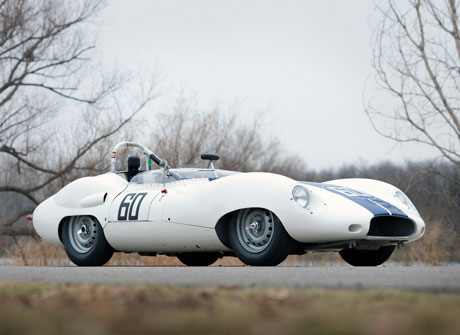SCM Analysis
Detailing
| Vehicle: | 1959 Jaguar Lister Costin Sports Racer |
| Original List Price: | n/a |
| Chassis Number Location: | Tab on front shock tower |
| Engine Number Location: | On head between cams |
| Club Info: | Jaguar Clubs of North America 234 Buckland Trace Louisville, KY 40245 |
| Website: | http://www.jcna.com |
| Investment Grade: | B |
This car sold for $1,100,000, including buyer’s premium, at Gooding’s Scottsdale Auction in Scottsdale, Arizona, on January 22, 2010.
In all of vintage racing, there is no more desirable or collectible category of cars than the front-engined sports racers that ran in international and SCCA competition from the mid 1950s into the early 1960s. As a group, they embody beautiful shapes, wonderful sounds, and exhilarating performance combined in packages that, primarily due to the skinny, hard tires available in the era and the relatively primitive tracks on which they ran, are enjoyable for the amateur racing car driver.
That said, there are at least four and possibly five distinct hierarchies that define the desirability and value of the various cars in the group.
The top rank is limited to Ferraris. They have it all: beauty, exclusivity, exotic mechanical packages, huge international dominance, and a particular, almost feminine sexiness that makes men’s knees and wallets weak.
The second rank is made up of Ferrari’s serious rivals for the Manufacturer’s Championship-Maserati, Aston Martin, and Jaguar being the most obvious. They built complete packages, including engines and drivetrains, which gives a value the lesser cars don’t have.
The third rank is specialist manufacturers that used outside engines and drivetrains in professionally built chassis with proper alloy bodywork, ideally aimed at European competition. Of these, Lister is probably the best.
The fourth rank involves production fiberglass bodies and American V8 engines (Devin), while homebuilts make up the bottom of the value range.
As you descend through the range, the collector values decrease relative to what I call the “weapons grade” components. At the top, history, provenance, original engine and bits, etc. are hugely important to the value, while at the bottom it’s whether you can get an entry and how much fun you can have with the big boys. Listers fit into the middle tier, where the two aspects are in balance.
A great problem with Listers is that virtually all of them were horribly abused in their “just old race cars” days: Cars were wrecked, chassis were replaced (often without disposing of the old one), engines thrown away, nobody really kept records of what happened, etc. The result is that there are very few “pure” Listers in existence-most have some stories. This tends to keep owners or potential buyers from being too concerned with originality and more interested in going fast and having fun.
Lister cars were robust, effective, and fast
A brief history is probably in order here. Brian Lister was a very competent engineer who built himself a ladder-framed special with an MG engine in 1954. It was competitive, and over the years his company refined the concept with different engines (most notably Bristol) until they built a Jaguar D-type-engined version in 1957.
That car, driven by Archie Scott Brown, was very successful and led to the big Lister sports racers in 1958 and 1959. The cars were not particularly sophisticated, being developments of the 1954 design, but they were robust, effective, and fast. The factory offered them with 3- or 3.8-liter D-type engines (European competition was limited to 3 liters in those days, so the 3.8 was primarily for U.S. use) or with Chevy V8s.
The Chevy cars were all shipped to the U.S. without engines or transmissions; Jim Hall and Carroll Shelby installed them on arrival. The body design for the 1958 cars was effectively an alloy skin pulled as tightly over the components as was possible to reduce frontal area, with the result that the appearance was very bumpy, or “Knobbly,” thus the name.
As mentioned in the catalog description above, in an attempt to remain competitive, Lister hired aerodynamicist Frank Costin to design a more slippery shape for 1959. Costin’s theory was that a smooth shape mattered more than frontal area, but he was incorrect. The Knobbly had lower drag, and most people like that design better as well.
V8 makes much more power than the Jag
Listers come in four basic variants-Knobbly and Costin, Jaguar and Chevy. Most of the Knobblies used Jaguar engines; all but two of the Costins were Chevy powered. European competition in the era was strictly Jaguar powered, while America got some of the Jags and all of the Chevys. The V8 makes easily half again more horsepower than the Jaguar with about the same weight, so the Chevys are much faster than the Jags, but can be quite a handful. The Jaguar-powered cars are generally considered to be a better balance of power and handling, which makes them more user-friendly, if not quite as quick. European racers seem to prefer the Jaguar cars; American buyers tend toward (surprise) the Chevys.
BHL123 crossed the auction block as one of the better, but certainly not the best, Lister Jaguars. On the good side, it was beautifully presented, the recent history and previous owner are well known and respected, and the history of BHL123 is impressive.
But its ownership history in the earlier days is long and complicated, plus it makes no claim to an original engine or transmission. Listers have long fallen well short of $1 million, even in the crazy markets of the last few years, while this one sailed through, and the question is why?
Maybe the previous cars weren’t good enough? Maybe the market for Listers is changing, with the value dragged up by the first- and second-tier cars they run with? Maybe somebody just got carried away at an auction? No matter which applies, I’d say this car was very well sold.
